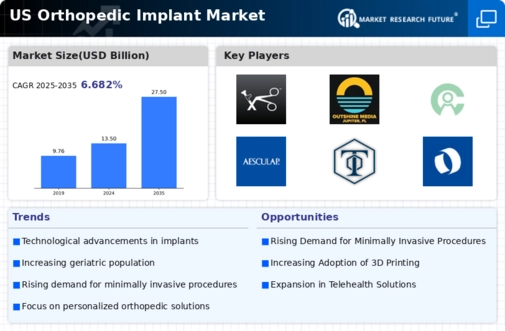Increased Healthcare Expenditure
The orthopedic implant market is benefiting from rising healthcare expenditure in the US, which has seen a steady increase over the past decade. In 2025, healthcare spending is expected to reach approximately $4.5 trillion, with a significant portion allocated to orthopedic care. This increase in funding allows for the adoption of advanced surgical techniques and high-quality implants, thereby enhancing patient outcomes. As hospitals and clinics invest in state-of-the-art technology and equipment, the demand for orthopedic implants is likely to rise, further propelling market growth.
Innovations in Implant Materials
Innovative materials are transforming the orthopedic implant market, enhancing the performance and longevity of implants. Recent advancements in biocompatible materials, such as titanium alloys and polyethylene, have improved the integration of implants with bone tissue. These innovations not only reduce the risk of complications but also extend the lifespan of implants, which is crucial for patients requiring long-term solutions. The market for orthopedic implants is projected to grow at a CAGR of 6.5% through 2027, largely fueled by these material advancements that promise better outcomes for patients.
Growing Awareness of Orthopedic Health
There is a notable increase in public awareness regarding orthopedic health, which is positively impacting the orthopedic implant market. Educational campaigns and initiatives by healthcare organizations are informing the population about the importance of early diagnosis and treatment of orthopedic conditions. This heightened awareness is leading to more individuals seeking medical attention for joint pain and mobility issues, resulting in a higher volume of surgical procedures. As patients become more proactive about their orthopedic health, the demand for implants is expected to grow, reflecting a shift towards preventive care.
Expansion of Outpatient Surgical Centers
The orthopedic implant market is witnessing growth due to the expansion of outpatient surgical centers across the US. These facilities offer a more cost-effective and efficient alternative to traditional hospital settings for orthopedic procedures. With advancements in minimally invasive techniques, many joint replacement surgeries are now performed on an outpatient basis, allowing patients to recover in the comfort of their homes. This trend not only reduces healthcare costs but also increases patient satisfaction, thereby driving the demand for orthopedic implants as more individuals opt for these convenient surgical options.
Rising Incidence of Orthopedic Disorders
The orthopedic implant market is experiencing growth due to the increasing prevalence of orthopedic disorders such as osteoarthritis and osteoporosis. According to recent data, approximately 30% of adults aged 65 and older are diagnosed with osteoarthritis, leading to a higher demand for joint replacement surgeries. This trend is likely to continue as the population ages, with projections indicating that by 2030, the number of total knee replacements in the US could reach 3.5 million annually. The rising incidence of these conditions necessitates advanced orthopedic implants, thereby driving the market forward.























Leave a Comment